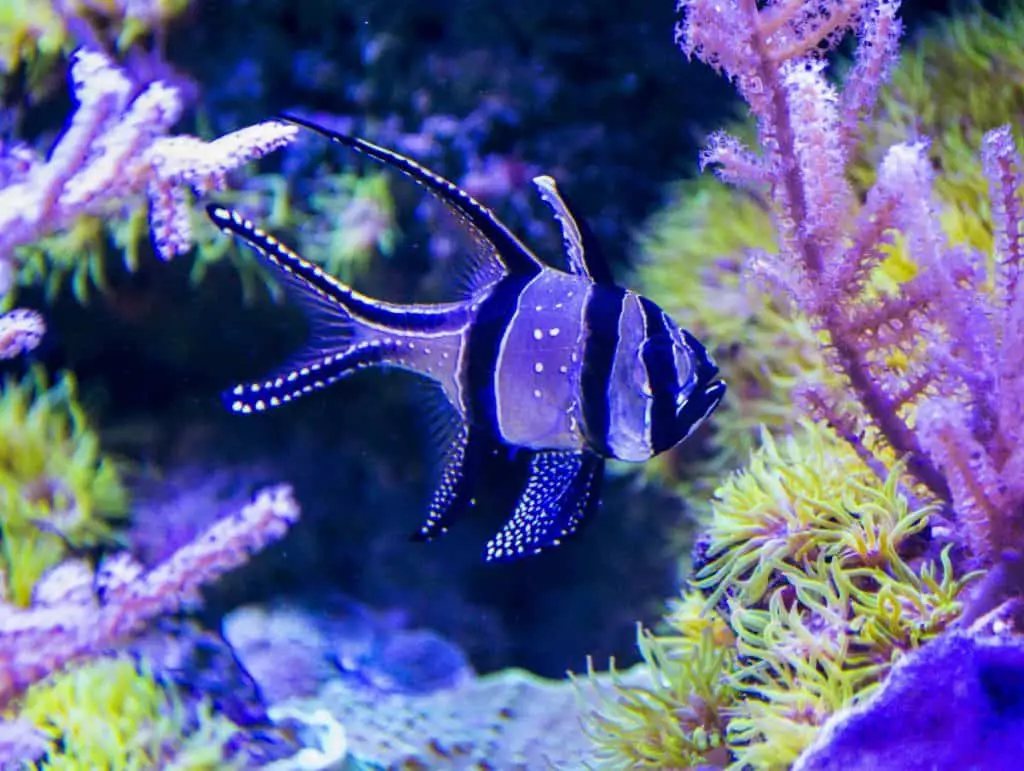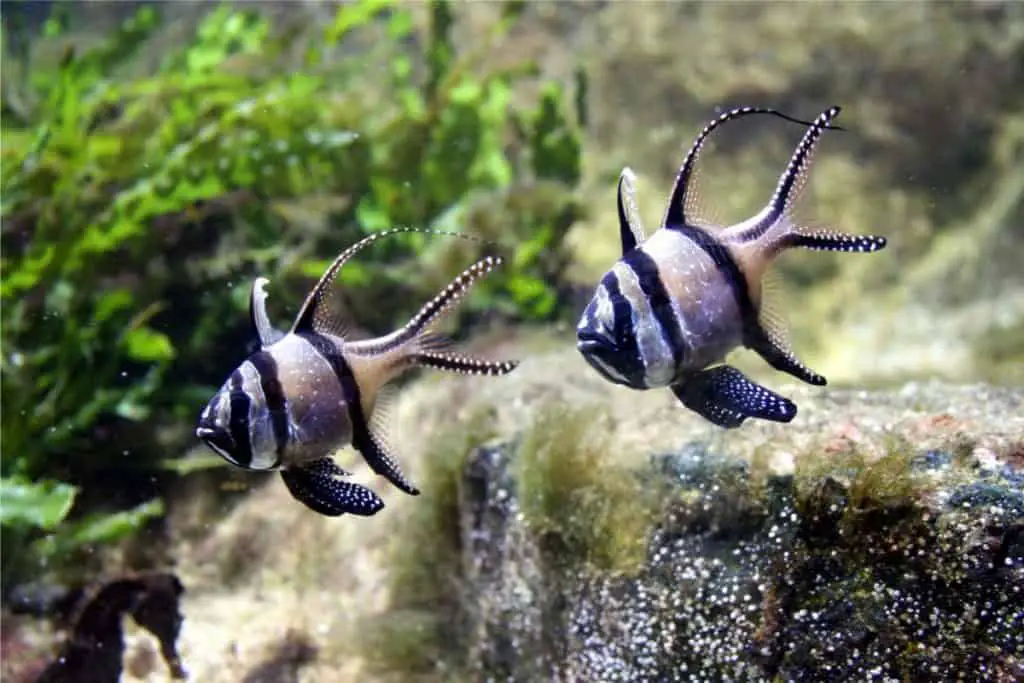I don’t know about you, but I’m a real sucker for a good looking saltwater fish with unique qualities! And that is why, I instantly and unequivocally fell in love with the Banggai Cardinalfish (
Undoubtedly there are more colorful and more gregarious saltwater fish out there than the Banggai Cardinalfish that will fill your aquarium with life and activity. However, none of them are as elegant, graceful, and serene as this wonderful species. They are interesting to watch whilst they hover in amongst coral and anemones and intriguing to view when they come out into the dimness of evening.
Intrigued? Well read on and learn all about this amazing species with our complete guide to the Banggai Cardinalfish.
Table of Contents
Species Profile: In the wild & aquarium
Normally in this section, we would touch upon some of the characteristics and care before we cover these things in greater detail later. However, we are not going to do that this time. Rather, we are going to look at the plight of the Banggai Cardinalfish and the ‘care’ which they need to survive in the wild.
First introduced to the aquarium trade in 1995/6 the Banggai Cardinalfish quickly, but not surprisingly, grew in popularity, and remains so to this day. However, this ‘popularity’ has come at a cost, and the price being paid is a huge decline in the wild population.
By 2001, 600,000 to 700,000 wild Banggai Cardinalfish were being caught and exported into the aquarium trade leading to a 90% decline in population in the present day. Despite this, and the fact that they were placed on the IUCN (International Union for Conservation of Nature) endangered list in 2007, they are still available wild caught today.
In fairness, to the aquarium trade, they did foresee this coming and took some action in 2000. It was then that they introduced a substantial population of Banggai Cardinalfish 400 km north of their natural area in the Lembeh Strait. This did not, however, as shown by the 2007 decision by the IUCN make a lot of difference; the species is still heading into decline.
There is, however, hope, and it lies in something that we can do. We need to stop purchasing wild-caught Banggai Cardinalfish. There are now, more so than ever, plenty of captive breeders breeding for the aquarium trade, and we need to be buying from them.
| Scientific Name | Pterapogon Kauderni |
|---|---|
| Common Name | Longfin Cardinalfish, Kaudern’s Cardinal, Banggai Cardinalfish |
| Family | Apogonidae |
| Origin | Banggai Archipelago, Indonesia, Asia |
| Lifespan | 5+ years |
| Sociability | Peaceful |
| Growth | Maximum 3-3.5 inches |
| Diet | Carnivore |
| Ideal foods | Live foods, Flakes, Brine Shrimp, Copepods, Mysis shrimp, Saltwater pellets |
| Minimum Tank Size | 30 gallons (pair), 100 gallon (small group) |
| Ideal first fish? | Yes |
| Tank Level | Mid to top level swimmers |
| Jumpers | No, odds ones have been know to jump out of the tank. But not common. |
| Care Level | Easy |
| Disease known | Nothing specific-All the standard saltwater fish disease |
| Water Parameters | 72-78℉ or 22-26℃, dKH 8-12, pH 8.1-8.4, sg 1.020-1.025 |
| Breeding | Mouthbrooder |
| Desirability | High |
| Cost | $30 |
| Reef safe | Yes |
How big does a Banggai Cardinalfish grow?
Reaching a maximum size of 3-3.5 inches (8cm’s) the Banggai Cardinalfish is by no means the most impressive saltwater fish by size. However, what it lacks in this department it makes up for in attractiveness. It is elegant, unique, and incredibly distinctive; a real aquarium showstopper.
Differentiated from other saltwater aquarium fish by its tasseled first dorsal fin, second dorsal fin rays, and a forked caudal fin, the Banggai Cardinalfish certainly stands out in a crowd. That is not to mention its stunning coloration of three black bars across its head, and body, and its prominent black anterior edges on some of its fins. The body and fins are also strewn with a myriad of white dots, the most prominent of which are on the fins.
Where do Banggai Cardinalfish come from?
The Banggai Cardinalfish is native to the 17 large and 10 small islands within the Banggai archipelago located off the coast of Indonesia. They have a relatively small range of 5500 km squared and a very small population of just, an estimated, 2.4 million.
The Banggai Cardinalfish dwells amongst the silty seagrass beds, sea anemones, mangrove roots, and coral ledges by day. By night they move more into the open feasting upon benthic and planktonic crustaceans. They are found in very large groups of between 200 to 600, with juveniles and adults all sharing the same space.
Are Banggai cardinalfish peaceful or aggressive?
If you’re looking for a gregarious species of saltwater fish for your aquarium that will give you action to watch all day long, the Banggai Cardinalfish is probably not for you. They are better suited to aquarists who desire a peaceful, and sedate aquarium with visually stunning fish.
Having said that, the Banggai Cardinalfish is no pushover, and will, when put in situations it does not like, such as being overcrowded, involve itself in minor scuffles. Usually, these do not go passed chasing, nudging, and fin-flicking, with no real harm being done.
Usual behavior for this species is being docile and shy with other fish. They are also nocturnal and like to spend their days hiding in amongst coral and anemones. They can, nonetheless, become used to being out and about during daylight hours given regular encouragement. This ‘encouragement’ should take the form of feeding which a Banggai Cardinalfish can always be tempted by.
It is worth bearing in mind that Banggai Cardinalfish may act differently depending on the number of them being kept in an aquarium. Larger groups will split into units and reside in different parts of an appropriately sized aquarium, whilst larger groups in smaller aquariums will fight. Pairs, which would seem to be the solution in a smaller aquarium, are also not bulletproof. If both turn out to be male there may be some minor fighting which will need addressing.
Banggai Cardinalfish care information
Banggai Cardinalfish thrive in a spacious reef setting that has plenty of overhangs, nooks, and crannies. They also require good filtration and brisk water movement to be at their optimum health. Subdued lighting is also something that should be considered, though is not essential, as they prefer darker environments due to being nocturnal.
These fish would also be one of my first picks for a smaller nano reef tank aquariums. For more information on these type and style of aquariums read out Nano reef tank article.
Aquarium size recommendations vary dependent on the number of Banggai Cardinalfish you plan on keeping. Groups of 8 plus, which is preferential, will need at least 100 gallons, whilst pairs require 30 gallons plus. This is mainly to prevent them from fighting with each other over territory.
When purchasing Banggai Cardinalfish, as we have stated before, it is in the best interests of the species to buy captive bred. This is not just for conservation purposes, but also because they are well known to be hardier in the home aquarium than wild caught. Care will still need to be taken when introducing them to their new home, and they should be acclimated carefully.
You should also take care when choosing Banggai Cardinalfish for your aquarium. Signs that the specimen is healthy include:
- Clear eyes
- Eating vigorously
- Fins intact and undamaged
Signs that a specimen is unhealthy or sick include:
- Loss of color/appetite
- Spots or fungus on body/mouth
- Labored breathing
- Weight loss
- Cloudy eyes
- Erratic swimming
- Frayed fins
Banggai Cardinalfish are fairly disease resistant and hardy but can be prone to common health issues such as:
- Marine Ich which will show itself in the form of cysts on fins, gills, and skin, labored breathing, excess skin mucus, and pale skin. Treatment includes using a commercial parasite remedy and improving water quality. Freshwater dips can also be used, with care, to dislodge the parasites.
- Fin Rot which the symptoms of are frayed or disintegrated fins with the tips reddening. Treatment should be to improve the water quality and use a commercial treatment where necessary.
Most disease can be

What do Banggai cardinalfish eat?
They are pradominatly carnivores that can be found in their natural habitat feasting upon benthic and planktonic crustaceans at night. This means that in the home aquarium they also require a meaty diet with at least one feeding at night.
Foods that are suitable include mysis shrimp, brine shrimp, finely chopped krill, cockles, and clam meat. If possible these should be vitamin enriched to ensure a nutritional diet.
Banggai Cardinalfish do not take easily to eating a flake or pellet food though they can be encouraged to do so over time. Rather their food should preferably be in frozen or live form to ensure that they will eat.
We eventually got ours to eat small saltwater pellets made by Omega Marine Pellets and purchased from Chewy.com. Once they start to accept these types of foods you know they are receiving the correct nutrients. Then you need to mix up their diet with live foods and also Omega One seaweed stripes. Then you know you’re providing them with a balanced diet and acting as a responsible pet owner.
Due to being nocturnal at least one feed per day should be given with the aquarium lights out. Banggai Cardinalfish require three feedings per day to keep them in optimum condition.
Can you breed these fish?
The Banggai Cardinalfish is one of only a few saltwater fish that will breed relatively easily and regularly in captivity. This is great news for the survival of this species and also those who would like to breed them in their home aquarium.
The usual status quo for courting fish is that the male will approach the female. This is not the case with the Banggai Cardinalfish, however, with which the female approaches the male. She does this by coming up on him from behind whilst producing a vigorous trembling motion. One alongside the male she then tilts her body 30 degrees outwards from its vertical plane. She repeats this movement until the male either swims away uninterested or sporadically opens his mouth. This is the sign that the male is receptive to the female’s advances.
Once they are a mating pair, the female Banggai Cardinalfish will expel her eggs for the male to pick up. This takes, usually, no longer than 2 seconds with the eggs numbering no more than 90. These eggs are usually around 2-3 millimeters in size though that may vary depending on how large the male is. Believe it or not, the larger the male, the larger the eggs will be.
As with many species of fish, not all the eggs will make it into the male’s mouth; some will be dropped and then scooped up by other fish who will devour them at first chance. The male will also be able to detect dead eggs amongst the ones he has picked up and will expel them from his mouth. This means that Banggai Cardinalfish do not usually have large broods.
A male Banggai Cardinalfish that is carrying eggs is extremely conspicuous. This is due to their oral cavities enlarging during the time they are mouthbrooding to a huge size. This period, when they are carrying eggs, is arguably the only time when you can tell a male from a female as neither sex has distinguishable sexual features. That is other than males being usually larger than the female but that is not set in stone.
During the time the male is brooding the eggs, which is around thirty days, the female will only hang around for the first few days. During this time she will defend the male vigorously from predators but then she just disappears. During the time that the male is left alone with his brood, he will not feed.
Juveniles, when born, grow quickly and stay within their parent’s habitat after birth. They will, however, keep out of sight, hiding near sea urchins, corals, and anemones. The father, nor the mother unsurprisingly, does not display much caring behavior. Banggai Cardinalfish young are left to fend for themselves.
In the home aquarium, it is advisable that once the male is brooding the eggs, he should be removed from the main aquarium and put into a breeding one. That way once the fry are released you can put the male back into your main aquarium leaving you to feed and care for the young. Baby brine shrimp is the perfect food to offer using a turkey baster for ease.
Banggai Cardinalfish and Clownfish
As the Banggai Cardinalfish is a largely peaceful and shy species, they should not be placed with large and boisterous species as doing so may cause them to refuse to come out from hiding and feed. Rather, they should be housed with other small and peaceful species similar to themselves.
We have been asked a lot of times if Banggai Cardinals can live with clownfish as there seems to be some uncertainty on this topic.
Let us clear this up here and now, Banggai cardinalfish are fine to live with clownfish and many other species. I think the confusion started when someone added 5 clownfish and a few Cardinals to their aquarium and fighting broke out. This was due to the clownfish pairing up and arguing amongst themselves. The Banggai cardinalfish will have no issues with your clownfish.
Ideal species include some other species of Cardinalfish, Dwarf Angelfish, Blennies, Clownfish, and Gobies. With some care, you could also consider larger Angelfish, Damselfish, Groupers, Pseudochromis, Tangs, and Wrasses, filefish and many other species of saltwater fish. They are also reef safe so you can keep them with any type of corals, invertebrates and even shrimps.

Conclusion: Banggai Cardinalfish complete care guide
As previously stated, if you are looking for a super exciting, mega active species of saltwater fish that will entertain you all day and night long, then the Banggai Cardinalfish is probably not for you. You would be better off looking elsewhere for the showman of your aquarium.
However, if like me, you are looking for a centerpiece, or addition species to add to an aquarium of beauty, serenity, and charm, then the Banggai Cardinalfish is an absolute must, a necessity. They are all of the aforementioned and much, much more.
It is not, however, only the beauty and personality of the Banggai Cardinalfish that makes them a species worth keeping. The simplicity of their care is also attractive as is the ease of their breeding. For anyone who wishes to participate in a marine breeding experience, they are ideal.
Speaking of breeding, it would seem apt to finish on a reminder of the plight of the Banggai Cardinalfish and a plea for you to buy captive bred. After all, we do not want this species legacy to be that it is no longer surviving in the wild!
[author title=”About the Author”]

I have been working in the tropical fish industry for over 30 years now and I’m still learning. Everyday is a school day in this hobby. In my spare time I play golf very badly!


